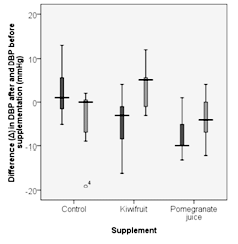The renin–angiotensin system (RAS) is a regulator of blood pressure (BP). Angiotensin-converting enzyme (ACE) catalyses the conversion of angiotensin I to angiotensin II, a potent vasoconstrictor, and is inhibited by pharmacological ACE inhibitors (ACEi). Some natural antioxidants possess hypotensive properties by acting as ACEi and reactive oxygen species (ROS) scavengers(Reference Aviram and Dornfeld1–Reference Kitiyakara and Wilcox3). The project examined the effects of the antioxidants in pomegranate juice (POMWonderful®; LLC, Los Angeles, CA, USA; PJ) and kiwifruit (KW) on the RAS and blood pressure (BP).
Forty-five (twenty-three females (F), twenty-two males (M)) student volunteers, aged 20.7 (sd 1.2) years, were recruited and fifteen volunteers per group were randomly assigned, using a block design, to either the control group (C; no supplementation) or the KW (two fruits per d) or PJ (166 ml/d) supplemented groups. Supplementation was additional to the normal diet over a 2-week period. Basal demographic data, BP and blood samples were taken before, during and at the end of the supplementation period. Simple dietary diaries were used to record the portions of fruit and vegetables and units of alcohol consumed per week. Plasma antioxidant and ACE concentrations were measured spectrophotometrically at each visit. Data are shown as medians and interquartile ranges (IQR).
Basal weekly fruit and vegetable intake was lower than the recommended intake in both genders (no. of portions; M, 15 (IQR 12–22); F, 19 (IQR 14–29)) while weekly alcohol intake was higher (units; M, 37 (IQR 16–59); F, 16 (7–24)). Both systolic BP (SBP; P<0.001) and diastolic BP (DBP; P=0.016) were higher in M than F overall, but the changes in BP with time were not different by gender. There was no significant change in DBP (mmHg) in group C (0 (IQR −5–13)) or group KW (–1.0 (IQR −4.0–5.0)), but in group PJ there was a significant (P=0.037) fall of −6.0 (IQR −10.0–0.0) (Fig. 1) after supplementation. No significant changes in SBP in relation to fruit intake were found. Plasma ACE and plasma antioxidant concentrations did not change significantly overall. However, M of group KW demonstrated both a significant decrease in plasma ACE concentration (P=0.022) (Fig. 2) and increase in antioxidant concentration (P=0.03) (Fig. 3). The high quantity of alcohol consumed was a significant confounder for SBP (P=0.024).

Fig. 1.

Fig. 2.

Fig. 3.
The significant fall in DBP after supplementation with PJ is interesting. As the sample size was small and there were potential confounders the reason for this decrease is unclear, but ROS scavenging, rather than ACEi, may be the cause. The lack of any decreases in SBP may be related to the high alcohol consumption and low dietary fruit and vegetable intake across the majority of volunteers.





